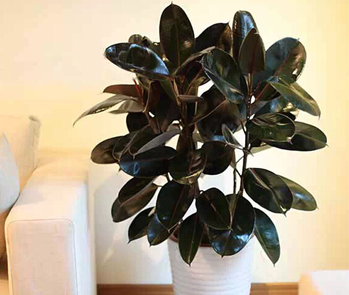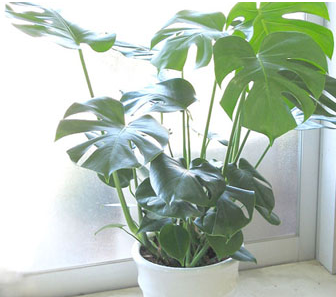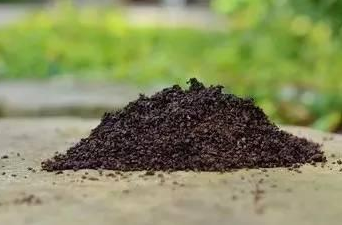How long does it take to water the leaves of a rubber tree?
Rubber tree, is a super magic, many people like, looking at this green shining plant, the mood is much better, to see how the rubber tree leaves? How long does it take to water the rubber tree:

What if the rubber tree loses its leaves:
Reason 1: lack of light
Rubber trees like the sun, if placed in the dark for a long time, lack of light, poor photosynthesis, leaves will fall due to lack of nutrition.
Solution: it is recommended to put the rubber tree in a sunny place, try to avoid the light time is too short, but in summer, the sun is fierce, it is best to put it indoors where the sun can shine.
Reason 2: too low temperature
Rubber trees like high temperatures and are suitable for growing at 20-25 degrees Celsius, while in winter, the room temperature is generally below 20 degrees Celsius. At this time, the loss of leaves is also very normal.
Solution: turn on the heat in winter and keep the room temperature between 20 and 25 degrees Celsius to avoid a large area of rubber tree leaves falling.
Reason 3: pest attack
Rubber trees are easy to suffer from anthracnose. The pathogen is Microsporum monosporium. After the disease, round or oval gray spots appear on both sides of the veins, and the long-term disease spots become one, damaging the leaves and causing the leaves to fall.
Solution: remove diseased branches, reduce pathogens, pay attention to indoor ventilation, and properly use Bordeaux solution, potassium permanganate, chlorothalonil and carbendazim spray leaves. If the disease is serious, take new branches to cut and propagate.
How long does it take to water the rubber tree:
1. Summer watering time
If the rubber tree is placed indoors, the light time is short, the water dispersion is slow, it does not need to sleep frequently, it can be watered every 7 days; if placed outdoors, the leaves are easy to dry and water every 3 days in order to keep the leaves moist.
2. Watering time in winter
In winter, rubber trees need to be put indoors and watered once a month, or without watering, wipe the leaves with a wet cloth directly. If the indoor heating is turned on, it is best to put a basin of water next to the rubber tree to increase the humidity of the indoor air and prevent the rubber tree from being too dry.
3. Daily watering time
The daily temperature is not less than 15 degrees Celsius, nor more than 30 degrees Celsius. Watering when the surface of the basin soil is white or the leaves are too dry, replenish the moisture of the leaves and keep the basin soil wet. When watering, remember not to water too much so as not to rot the roots of the rubber tree.
This is the end of the treatment method and watering time for the rubber tree to lose its leaves. Hurry up and turn the rubber tree into a good-looking tree.
The reason for the yellowing of the leaves of the rubber tree, what if the rubber tree loses its leaves?
Rubber tree is a common potted plant, because the leaf shape is unique, a lot of flower friends are farmed, when raising rubber tree, it is inevitable to encounter rubber tree leaf yellowing, losing leaves and other phenomena, so the ornamental value of rubber tree is greatly reduced, but when you encounter rubber tree leaves yellowing, do not worry about falling leaves, to analyze the causes of rubber tree leaves yellowing, the following finishing rubber tree leaves, leaf yellow common 5 reasons.
Analysis on the causes of yellowing and falling leaves of rubber trees 1. Leaves yellowed without changing pots for a long time
Rubber trees usually need to change their pots once a year. Bonsai is a little bigger every year, and can be changed every three years after growing for 6 to 8 years. If you do not change the basin for a long time, it will make the soil hardening, the soil ventilation condition is not good, will lead to rubber tree whisker root asphyxiation and necrosis, can not absorb water and nutrients, resulting in leaf fall.
Solution method
If the temperature reaches above 15 ℃ in spring, change the basin in time. Cut off the dead roots and shake off most of the persistent soil. Remove the yellowed leaves, truncate the stem, and replace it with fertile soil. After changing the basin, keep the basin soil moist, loosen the soil once every 15-20 days, so as to avoid repeated watering leading to basin soil consolidation and cause rotten roots or root atrophy.
2. Malnutrition leads to leaf yellowing
Rubber trees like big fat and water, and long-term non-fertilization and watering will cause malnutrition, resulting in yellowing and falling leaves.
Solution method
When changing the basin, add the base fertilizer, remove the yellow leaves in time, and apply fertilizer once a month, mainly phosphorus and potassium fertilizer. During maintenance, we often observe the wetting degree of the basin soil, replenish water in time, and spray water to the leaves every morning and evening. Note that the water temperature is basically the same as the soil temperature, so as to avoid excessive disparity, resulting in poor plant growth.
3. Excessive watering or fertilization leads to yellowing of leaves.
Although rubber trees like water and fertilizer, if there is too much watering and fertilization, especially from August to September, the weather is muggy, too much watering, the basin is easy to accumulate water, or overwintering, the plant is in a dormant period, and the transpiration is weak, the water in the basin can not be discharged in time. Or mistakenly apply raw fertilizer, big fertilizer, thick fertilizer, will cause plant water damage, fertilizer damage.
Solution.
Cut off the rotting root system, and white milk will flow out from the mouth. Then use plant ash to dry the milk, reduce water evaporation, wait for the cut to dry and then replant. After replanting, pay attention to control watering and fertilization, you can spray water to the leaves sooner or later.
4. Lack of ventilation leads to yellowing of leaves
The indoor wind is different for a long time, the environment is muggy, accumulating a large number of harmful gases, even if the rubber tree has the role of purifying the air, it is difficult to face this situation.
Solution.
Open the window in time to keep the indoor air fresh. In winter, windows can be opened to change indoor air at noon when the temperature is high.
5. Diseases lead to yellowing of leaves.
The conservation environment is not suitable, and rubber trees are vulnerable to Botrytis cinerea, which needs timely prevention and control.
Solution.
Timely removal and destruction of diseased leaves and timely cleaning of withered leaves. Appropriately increase indoor light and increase room temperature. When diseased leaves are found, spraying 600 times of chlorothalonil wettable powder solution in time, 7: 10 can be sprayed once for 2 or 3 times in a row, which can effectively control the spread of bacteria.
Analysis of the reasons for the loss of leaves of rubber trees and their solutions what to do with the loss of leaves of rubber trees?
Rubber tree is an evergreen foliage plant with large glossy round to oval leaves with dark green leaves and high ornamental value. it is a famous potted foliage plant. It is very suitable for indoor beautification. Small and medium-sized plants are often used to beautify the living room and study; medium and large plants are suitable to be arranged on both sides of the foyer of large buildings and in the center of the lobby, which is magnificent and can reflect the tropical scenery. But at the same time, there will be some minor problems, such as yellowing and falling leaves after a period of time, what to do. Today, I would like to introduce to you the reason why the leaves of the rubber tree have lost its leaves and the solutions.
1. Soil consolidation caused by not changing the basin for a long time
Rubber trees usually need to change their pots once a year. Bonsai is a little bigger every year, and can be changed every three years after growing for 6 to 8 years. If you do not change the basin for a long time, it will make the soil hardening, the soil ventilation condition is not good, will lead to rubber tree whisker root asphyxiation and necrosis, can not absorb water and nutrients, resulting in leaf fall.
Solution method
If the temperature reaches above 15 ℃ in spring, change the basin in time. Cut off the dead roots and shake off most of the persistent soil. Remove the yellowed leaves, truncate the stem, and replace it with fertile soil. After changing the basin, keep the basin soil moist, loosen the soil once every 15-20 days, so as to avoid repeated watering leading to basin soil consolidation and cause rotten roots or root atrophy.
2. Fertilizing without watering for a long time
Rubber trees like big fat and water, and long-term non-fertilization and watering will cause malnutrition, resulting in yellowing and falling leaves.
Solution method
When changing the basin, add the base fertilizer, remove the yellow leaves in time, and apply fertilizer once a month, mainly phosphorus and potassium fertilizer. During maintenance, we often observe the wetting degree of the basin soil, replenish water in time, and spray water to the leaves every morning and evening. Note that the water temperature is basically the same as the soil temperature, so as to avoid excessive disparity, resulting in poor plant growth.
III. Watering or fertilizing too much
Although rubber trees like water and fertilizer, if there is too much watering and fertilization, especially from August to September, the weather is muggy, too much watering, the basin is easy to accumulate water, or overwintering, the plant is in a dormant period, and the transpiration is weak, the water in the basin can not be discharged in time. Or mistakenly apply raw fertilizer, big fertilizer, thick fertilizer, will cause plant water damage, fertilizer damage.
Solution.
Cut off the rotting root system, and white milk will flow out from the mouth. Then use plant ash to dry the milk, reduce water evaporation, wait for the cut to dry and then replant. After replanting, pay attention to control watering and fertilization, you can spray water to the leaves sooner or later.
IV. Improper ventilation
The indoor wind is different for a long time, the environment is muggy, accumulating a large number of harmful gases, even if the rubber tree has the role of purifying the air, it is difficult to face this situation.
Solution.
Open the window in time to keep the indoor air fresh. In winter, windows can be opened to change indoor air at noon when the temperature is higher.
Fifth, infection with Botrytis cinerea
The conservation environment is not suitable, and rubber trees are vulnerable to Botrytis cinerea, which needs timely prevention and control.
Solution.
Timely removal and destruction of diseased leaves and timely cleaning of withered leaves. Appropriately increase indoor light and increase room temperature. When diseased leaves are found, spraying 600 times of chlorothalonil wettable powder solution in time, 7: 10 can be sprayed once for 2 or 3 times in a row, which can effectively control the spread of bacteria.
About the reasons for the loss of leaves of rubber trees and solutions, let's stop here today. If you want to know more about rubber trees, please continue to follow the succulent flower beds. We will provide you with more relevant information.
- Prev

Is the tortoise back bamboo poisonous? what are the methods of reproduction and pruning?
Speaking of this tortoise back bamboo, this is a lot of people like to raise, the leaves are bright green, let's see if the tortoise back bamboo is poisonous? What are the breeding and pruning methods of tortoise-backed bamboo: is tortoise-backed bamboo poisonous? tortoise-backed bamboo is slightly toxic and mainly absorbs water from its roots. When the temperature is low, water droplets will condense on the leaves.
- Next

The method of raising flowers with coffee grounds to supplement nitrogen fertilizer Snotlout nemesis
When it comes to coffee, many people like to drink coffee very much now. So many coffee grounds are poured all over the place. Nutritious environment, coffee grounds are also very nutritious. Let's take a look at how coffee grounds grow flowers: mulch, coffee grounds are also good mulch, they can help keep moisture in the soil.
Related
- Fuxing push coffee new agricultural production and marketing class: lack of small-scale processing plants
- Jujube rice field leisure farm deep ploughing Yilan for five years to create a space for organic food and play
- Nongyu Farm-A trial of organic papaya for brave women with advanced technology
- Four points for attention in the prevention and control of diseases and insect pests of edible fungi
- How to add nutrient solution to Edible Fungi
- Is there any good way to control edible fungus mites?
- Open Inoculation Technology of Edible Fungi
- Is there any clever way to use fertilizer for edible fungus in winter?
- What agents are used to kill the pathogens of edible fungi in the mushroom shed?
- Rapid drying of Edible Fungi

